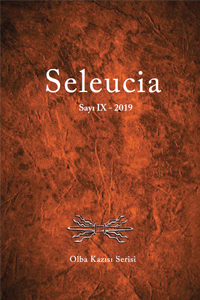Kirsu’dan Meydancıkkale/Kilikia Yüksek/Kabarık Torus’lu İki Kaide ve Anadolu Mimarlık Tarihi Açısından Değerlendirmesi
Kiršu, Meydancıkkale, Akhamenid Dönem, yüksek/ kabarık toruslu kaide
Kirsu’dan Meydancıkkale/Kilikia Yüksek/Kabarık Torus’lu İki Kaide ve Anadolu Mimarlık Tarihi Açısından Değerlendirmesi
Kiršu, Meydancikkale, Achaemenid Era, torus base,
___
- Alkım 1974 Alkım, U.B., Yesemek. Taşocağı ve Heykel Atelyesinde Yapılan Kazı ve Araştırmalar, Ankara.
- Alp 2008 Ahmet Oğuz, A., “Hellenistik-Roma Dönemi Anadolu Mimarlığında Bezemeli Kaideler”, Anadolu - Anatolia 34, Ankara.
- Baus 1965 Baus, K., Der Kranz in Antike und Christentum, Bonn.
- Brixhe - Panayotu 1992 Brixhe, C. - Panayotou, A.,“Asie Mineure”, Bull. Epigr. 1992 fasc. 502- 503, no. 537.
- Brixhe 1998 Brixhe, C., “Les Inscriptions Grecaues”, Gülnar I, , 345-353, Paris.
- Casabonne 1999 Casabonne, O., “Local Powers and Persian Model in Achaemenid Cilicia: A Reassessment”, Olba II-I, Mersin.
- Casabonne 2004 Casabonne, O., Le Cilicie a l’epoque achemenide, Persika 3, Paris.
- Davesne 1981 Davesne, A., “Meydancıkkale Kalesi 1980 Kazı Dönemi ve Hazine”, KST III, 11-15.
- Davesne - Lemaire - Lozachmeur 1987 Davesne, A. - Lemaire, M.A. - Lozachmeur, M.H., “Le site Archeologıoue Meydancıkkale: Du Royaume de Pirindu a la Garnison Ptolemaioue”, Academie des Inscriptions-Belles Lettres.
- Davesne - Rider 1989 Davesne, A. - Rider, G., Gülnar II. Le Tresor de Meydancıkkale, Paris.
- Durukan 2007 Durukan, M.,“Seramikler Işığında Nagidos”, Dağlık Kilikia’da Bir Antik Kent Kazısının Sonuçları: Nagidos (Ed. S. Durugönül), İstanbul.
- Durugönül 1998 Durugönül, S., “Seleukosların Olba Territorium’undaki Akkulturation Süreci Üzerine Düşünceler”, Olba I, Mersin.
- Erzen 1940 Erzen, A., Kilikien bis zum Ende der Perserherrschaft, Leipzig.
- Feld - Weber 1967 Feld, O. - Weber, H., “Tempel und Kirche der Korykischen Grotte (Cennet Cehennem) in Kilikien”, IstMitt 17.
- Von Gall 1966 Von Gall, H., Die paphlagonischen Felsgräber, Tübingen.
- Gates 2005 Gates, C., “The Place of the Achaemenid Persian Period in Archaeological Research in Cilicia and Hatay (Turkey)”, Persika 6.
- Gülnar I Gülnar I. Le site de Meydancıkkale (ed. A. Davesne-F. LarocheTraunecker), 1998, Paris.
- Hanfmann - Ramage 1978 Hanfmann, George M.A. - Ramage, A., Nancy Sculpture from Sardis: Finds through 1975”, Cambridge.
- Held (baskıda) Held, W., “Seleukidische Tempel babylonischen Typs”, Orient und Okzident.
- Herodotos Herodot Tarihi (Çev. M. Ökmen), 2002, İstanbul.
- Işık 1996 Işık, F., “Pamfilya ve Anadolu Gerçeği”, Adalya I, İstanbul.
- Kaplan 2013 Kaplan, D., “Arkaik-Roma Dönemi Mimari Elemanlarının/ Süslemelerinin Kataloğu ve Değerlendirilmesi”, Silifke Müzesi Taş Eserler Kataloğu. Heykeltıraşlık ve Mimari Plastik Eserler (ed. S. Durugönül), 153-182), İstanbul.
- Laroche - Davesne 1981 Laroche, M.E. - Davesne, A., “Les Fouilles de Meydandjık pres de Gülnar et le Tresor Monetaire Hellenistique”, Academie des InscriptionsBelles Lettres.
- Laroche-Traunecker 1993 Laroche-Traunecker, F., “Les edifices d’epoque archaique et greco-perse de Meydancıkkale (Gülnar)”, Les Grands Ateliers d’Architecture Dans Le Monde Egeen Du VI Siecle av. J.C.: Varia Anatolica III, İstanbul.
- Cahill (ed.) 2010 Cahill, N.D. Lydialılar ve Dünyaları, İstanbul.
- Mansel 1978 Mansel, A.M., Side. 1947-1966 Yılları Kazıları ve Araştırmalarının Sonuçları, Ankara.
- Naumann 2007 Naumann, R., Eski Anadolu Mimarlığı (Çev. B. Madra), Ankara.
- Özhanlı 2007 Özhanlı, M., “Side’de Bulunan Bir Yeni Hitit Eserinin Düşündürdükleri”, Adalya X, İstanbul.
- Rumscheid 1994 Rumscheid, F., Untersuchungen zur kleinasiatischen Bauornamentik des Hellenismus, Beitrage zur Erschliessung hellenistischer und kaiserzeitlicher Skulptur und Architektur Bd. 14, Mainz.
- Sevin 1999 Sevin. V., Yeni Assur Sanatı I. Mimarlık, Ankara.
- Söğüt 2005 Söğüt, B., “Ein hellenistisches Kapitell aus dem Rauhen Kilikien: Das korinthischesi Kapitell von Efrenk”, IstMitt 55, Germany.
- Summerer - von Kienlin 2010 Summerer, L. -von Kienlin, A., Achaemenid Impact in Paphlagonia: Rupestral Tombs in the Amnias Valley, in: J. Nieling - E. Rehm (edd.), Achaemenid impact in the Black Sea. Comunications of powers, Aarhus.
- Şahin 1991 Şahin, S., “Inschriften aus Seleukeia am Kalykadnos (Silifke), EA 17, Bonn.
- Ünal - Girginer 2007 Ünal, A. - Girginer, S., Kilikya-Çukurova: İlk Çağlardan Osmanlılar Dönemi’ne Kadar Kilikya’da Tarihi Coğrafya, Tarih ve Arkeoloji, İstanbul.
- Wannagat 1999 Wannagat, D., “Zur Saeulenordnung des Zeustempels von OlbaDiokaisareia”, Olba II-II, Mersin.
- Wannagat 2006 Wannagat, D., “Neue Forschungen in Uzuncaburç 2001-2004: Das ZeusOlbios-Heiligtum und die Stadt Diokaisareia”, AA 2005-I, Berlin.
- Wesenberg 1971 Wesenberg, B., Kapitelle und Basen. Beobachtungen zur Entstehung der griechischen Säulenformen, Beihefte Bonner Jahrbücher 32, Düsseldorf.
- Wuttmann - Laroche-Traunecker - Courtois 1998 Wuttmann, M. - Laroche-Traunecker, F. - Courtois, J.C., “Les Etats D’Occupation du Secteur Nord”, Meydancıkkale I, Paris.
- Yegül 2014 Yegül, F.K., “A Victor’s Message “The Talking Column of the Temple of Artemis at Sardis”, Journal of the Society of Architectural Historians, Vol 73.26.
- Zoroğlu 1999 Zoroğlu, L., “Kilikya Berenikesi’nin Yeri”, Olba II-II, Mersin
- ISSN: 2148-4120
- Başlangıç: 2011
- Yayıncı: Bilgin Kültür Sanat Yayınevi
Mısır’da Phokaia Kolonizasyonu
Hellenistik Dönemdeki Güçler Dengesi Arasında Pamphylia’da Bir Liman Kenti: Side
Olba’daki Tapınak Cepheli Kaya Mezarı
Roma’da Krallık Dönemi: Kralın Belirlenmesi
Efrumiye ERTEKİN, Sehergül GÜL
Rodon Olba’dan Bir Roma İmparatoruna Gönderilen Elçi
Arkeolojik Veriler ve Tarihsel Olaylar Işığında Olba’da Yerleşimin Son Bulması
Kars Müzesi’nden Bir Grup Son Tunç Çağı Seramiğinin Değerlendirilmesi
